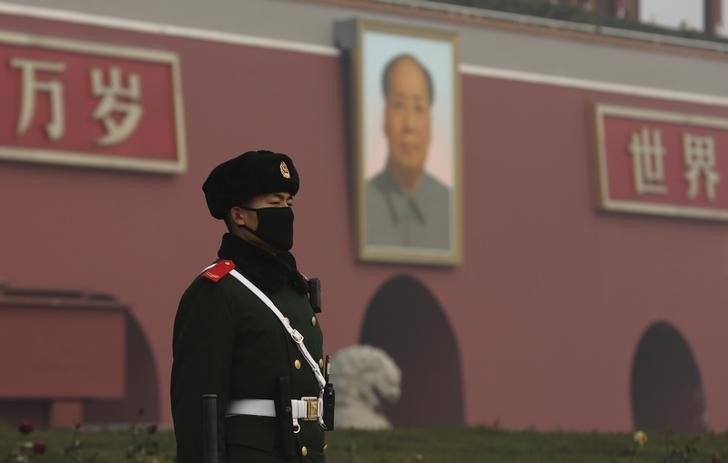(Bloomberg) -- China concluded its most important annual political meeting this week, rolling out a hefty increase in government borrowing as it dropped a decades-old practice of setting an economic growth target.
The economic support package entailed about 3.6 trillion yuan ($504 billion) in extra debt issuance and a widening of the deficit, which by a broad measure now stands at about 11% of gross domestic product.
Here are the key economic policy takeaways from the National People’s Congress meetings:
Jobs now come before GDP
- Numerical growth target dropped, the first time in decades
- Targets include poverty elimination, more than 9 million new urban jobs, inflation at around 3.5%
The omission of a hard growth target was a rare move in a country where the planning of the whole government apparatus is anchored on a goal for gross domestic product growth. The decision indicates that the reality of very weak growth for 2020 is increasingly accepted in Beijing, and it gives the government greater leeway in policy making as they try to avoid another round of massive stimulus and debt buildup.
The government instead stressed the need to keep unemployment down, companies solvent, food and energy secure, and household income stable. Official urban unemployment, which leaves out about half the workforce, stood at 6.0% in April and the government aims to keep it there. Over 100 million workers may have had their jobs disrupted by the coronavirus crisis.
Protecting “jobs, livelihoods and businesses will help us achieve positive and solid growth this year to the extent possible, and maintain steady economic development,” Premier Li Keqiang said at a closing press conference in Beijing Thursday.
The fiscal surge is bigger than it first appears
- The official fiscal deficit was set at “more than 3.6%” of GDP
- Targets for selling 3.75 trillion yuan in special infrastructure bonds, 1 trillion yuan of anti-virus sovereign bonds
- Companies given payment delays on social security fees, taxes
The broad fiscal impulse unveiled at the NPC could actually amount to about 11% of GDP in 2020, according to an estimate by David Qu and Chang Shu of Bloomberg Economics, assuming that the government spends all that it plans to.
Other estimates have fiscal stimulus at about 9% of GDP for the year, more moderate than the measures pledged by other major economies. Government spending should, in any case, rise faster than the expected expansion in the economy, to reach 37.4 trillion yuan, according to Bloomberg calculations.
Yet more could come should conditions require, Li assured investors on Thursday.
“Should any big changes take place in the economy or in other aspects, we’ve reserved policy space on the fiscal, financial, social security and other fronts, and we can issue new policies without hesitation,” Li said.
Policy makers in Beijing have formed “some new guiding principles” during the economic downturn in recent years, including a visible shift toward a restrained and measured approach in policy easing, Chang Jian, chief China economist at Barclays (LON:BARC) Plc in Hong Kong, wrote in a note. The government will likely “lean towards caution and release policy stimulus at a measured pace, rather than all at once.”
Monetary policy will target faster credit growth
- Cuts to central bank interest rates, banks’ reserve ratios to be used
- Credit growth to be “significantly higher” than 2019
- New tools to ensure funds “directly reach” the economy
Easier monetary policy from the People’s Bank of China (OTC:BACHY) is expected this year to complement the large amount of government bond sales and other fiscal stimulus. The pace of credit expansion will be “significantly higher” than last year, and officials have indicated that their tolerance for debt growth has increased.
Li’s work report also mentioned new monetary tools to “directly reach” the economy, without giving any detail about what that means. The comments sparked speculation on whether the PBOC would invent something resembling the U.S. Federal Reserve’s Main Street program to lend directly to businesses, but Governor Yi Gang has dialed back such hopes.Some of the existing monetary tools such as relending - a program that channels the central bank’s base money to targeted sectors such as small firms - have improved the “directness” of corporate financing, Yi said in a statement published on Tuesday.
He listed five tools the bank plans to use to promote easier credit policy, indicating the PBOC will focus on making monetary policy more effective, rather than flooding the economy with excessive liquidity.
We also learned that the legislature plans to start revising the law that governs the PBOC this year.
This infrastructure surge is all about technology
- China to step up construction of next generation networks and 5G applications
- New-energy automobiles, smart-manufacturing, industrial upgrading in focus
The government confirmed its existing intention to give the next push for infrastructure investment a heavy focus on high-tech communications, amid a $1.4 trillion effort to overtake the U.S. in such sectors.
“Priority will be given to new infrastructure and new urbanization initiatives and major projects, which not only boost consumption and benefit the people, but also facilitate structural adjustments and enhance the sustainability of growth,” according to Li’s Work Report.
©2020 Bloomberg L.P.
